Food Safety

Alabama Extension food safety and quality specialists help families, producers, processors, and food service workers stay safe from foodborne illness. They also conduct training that enhances employment opportunities, financial status, prospects for advancement, and overall quality of life.
Food Safety Training for Food Service Workers—ServSafe

Figure 1. Alabama Extension Food Safety and Quality team.
Project Leaders: Rebecca Catalena, Janet Johnson
Institutional Lead: 1862 Extension – AU
Coleaders/Collaborators: Susan Hill, Dani Reams, Bridgette Brannon, Angela Treadaway, Christy Mendoza, Alice Moore, Juani Christian
Background/Situation/Issue: The Food Safety Training for Food Service Workers program offers certification-based training through the nationally recognized ServSafe program, accredited by the American National Standards Institute (ANSI). This training adheres to the guidelines set forth by the 2022 Food and Drug Administration (FDA) Food Code. As part of state regulations, food establishments are required to have a certified food protection manager present on-site during all hours of operation. The primary objective of the Food Safety Training program is to ensure that food service establishments across Alabama comply with this regulation while also providing employees with the knowledge and skills necessary to prevent foodborne illnesses. By offering accessible training throughout sixty-six counties in Alabama, the program aims to safeguard public health, improve food safety practices, and support compliance with Alabama Department of Public Health (ADPH) requirements.
Outputs: In 2024, certified instructors and proctors from the Food Safety team conducted 99 two-day food safety classes across Alabama counties. These classes were designed to ensure food service workers are equipped with the necessary skills and knowledge to uphold food safety standards. As a result of these efforts, 826 food service workers successfully completed the training, achieving an 84% pass rate—a notable increase from the 76% pass rate in 2023. The ServSafe certification, valid for 5 years, helps retain ongoing food safety knowledge and standards in Alabama’s restaurants. In addition, through a partnership with Alabama A&M, the team expanded its reach and provided training and materials in Spanish for 35 workers, further increasing access to this essential program.
By offering these classes in rural counties across the state, the program provided food safety certification to workers, enabling businesses to remain open, continue generating revenue, and contribute to their local economies. For workers who did not pass the exam but still attended the 2-day training, an Hours of Training certificate was issued, which is valid for 1 year under ADPH guidelines.
The economic impact of these efforts extends beyond food safety. For every additional dollar spent in Alabama restaurants, $1.90 is contributed to the state’s economy. Additionally, every $1 million spent in Alabama restaurants generates 18.3 jobs. The Alabama Extension Food Safety team’s training of 826 food service workers, with an annual mean salary of $31,672, had a direct economic impact of $26.16 million on the state’s economy.
Audience Diversity: The Food Safety Training for Food Service Workers program attracted a diverse group of participants in 2024:
- 78% female, 21% male
- 98% adults, 2% youth
- Racial and ethnic diversity:
- 55% White
- 34% Black
- 4% Hispanic
- 6% Identified as Other
Evaluation Techniques: To assess the effectiveness of the Food Safety Training for Food Service Workers program, participants are required to complete an accredited exam, with a passing score of 70% or higher, in order to receive the 5-year ServSafe certification. This certification enables food service workers to meet national standards for food safety. In addition to the exam, post-training effectiveness surveys are conducted after each class to gather feedback from participants. These surveys help evaluate the relevance and impact of the training, providing valuable insights for continuous improvement and ensuring that the program’s objectives are being met.
Value Statement/Synopsis: In 2024, the Alabama Food Safety team trained 826 food service workers through the ServSafe program, each with an annual mean salary of $31,672. This training had a direct economic impact of $26.16 million on the state’s economy. With a 226:1 return on investment (ROI), the program’s value is undeniable. By providing current, research-based education aimed at increasing the safety of our food supply, we support Alabama’s restaurant industry, which generates more than $11 billion in sales and employs more than 200,000 people statewide. Our work not only contributes to the economic vitality of the state but also plays a crucial role in preventing foodborne illnesses, promoting public health, and ultimately saving lives.
Revenue Generation: $115,640
Social Media Channels: www.facebook.com/acesfoodsafety
Key Web Page: www.aces.edu/blog/topics/servsafe
Training to Sell Cottage Foods
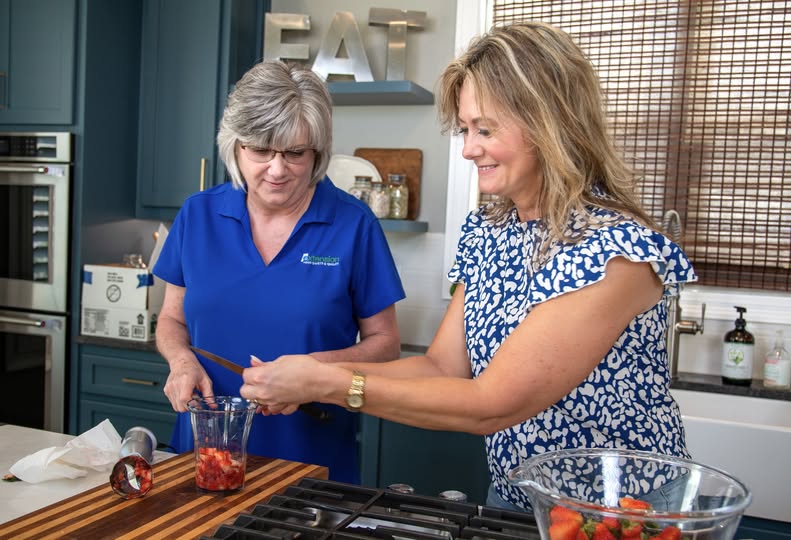
Figure 2. Alice Moore and Bridgette Brannon demonstrate proper food handling techniques.
Project Leader: Alice Moore
Institutional Lead: 1862 Extension – AU
Coleaders/Collaborators: Susan Hill, Bridgette Brannon, Angela Treadaway, Christy Mendoza, Dani Reams, Juani Christian, Rebecca Catalena, Janet Johnson
Background/Situation/Issue: The Cottage Food Law was established to address the unique challenges home-based businesses face, striking a balance between supporting entrepreneurship and safeguarding public health. While the law encourages the growth of cottage food industries, it also emphasizes the importance of food safety. By providing clear guidelines for safe food production, labeling, and sales, the law encourages cottage food producers to adhere to critical food safety standards, reducing the risk of foodborne illnesses. The law aims to foster entrepreneurship by empowering individuals to start small food businesses from their homes while making their products as safe as possible for consumers. The Cottage Food Law Training program plays a crucial role in equipping producers with the knowledge needed to meet these safety standards and successfully navigate the Alabama Cottage Food Law.
Outputs: In 2024, the Food Safety and Quality team played a pivotal role in helping individuals achieve certification in food safety under the Alabama Cottage Food Law. The team developed and delivered a comprehensive 2-hour course that covered essential topics, including food safety, canning, acidification, fermentation, and drying techniques. This training equipped participants with the knowledge required to produce and sell approved foods from their homes safely.
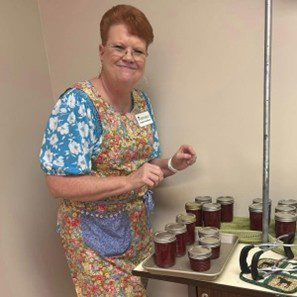
Figure 3. Angela Treadaway teaches proper home canning techniques.
The course combined instructional content with a final exam, allowing participants to earn certification upon successful completion. The team successfully trained 1,286 individuals, helping them meet legal requirements and empowering them to launch or grow home-based food businesses. The Cottage Food Law certifications earned through this training are valid for 3 years, allowing participants to remain compliant with state regulations over an extended period.
Audience Diversity: The Cottage Food Law Training program attracted a diverse group of participants in 2024:
- 86% female; 12% male; 2% choosing not to answer
- Age distribution:
- 3% 18 years old or younger
- 45% between the ages of 19 and 45
- 30% between the ages of 46 and 59
- 20% between the ages of 60 and 75
- 2% 76 years old or older
- Racial and ethnic composition:
- 75% White
- 15% Black
- 4% Identified as Other
- 3% Hispanic
- 3% Chose not to answer
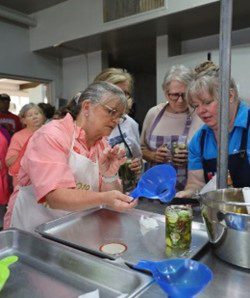
Figure 4. Christy Mendoza demonstrates proper canning techniques.
Evaluation Techniques: To evaluate the effectiveness of the Cottage Food Law Training program, educators asked participants to complete an accredited exam and achieve a passing score of 75 percent or higher to receive their 3-year Cottage Food Law certification. This certification equips individuals with the necessary knowledge to safely produce and sell cottage food products in compliance with state regulations.
Additionally, post-training demographic surveys are conducted for each class to gather information about participants’ backgrounds, ensuring a clear understanding of the program’s reach and the diversity of attendees.
Value Statement/Synopsis: In 2024, 1,286 individuals were certified, with 85 percent launching entrepreneurial businesses to generate additional income in the home. The program supports the viability of home food producers, who collectively have the potential to earn $5,940,223. With a 199:1 return on investment (ROI), the program’s value is clear. The 3-year certification means producers are trained in regulations, fostering a safe and reliable marketplace for consumers and producers.
Revenue Generation: $32,150
Social Media Channels: www.facebook.com/acesfoodsafety
Key Web Page: www.aces.edu/blog/tag/food-safety
Home Food Preservation:Garden to Pantry
 Project Leaders: Rebecca Catalena, Carmen Flammini, Dani Reams
Project Leaders: Rebecca Catalena, Carmen Flammini, Dani Reams
Institutional Lead: 1862 Extension – AU
Coleaders/Collaborators: Susan Hill, Janet Johnson, Alice Moore, Christy Mendoza, Angela Treadaway, Bridgette Brannon, Jack Lecroy, Alexia Simmons, Olivia Fuller, Tera Glenn
Background/Situation/Issue: In 2023, a needs assessment conducted by the Alabama Extension Food Safety and Quality team revealed that 91 percent of surveyed individuals expressed interest in a cross-discipline approach to growing and preserving their own food. This significant demand highlighted a gap in knowledge and resources related to sustainable food production and preservation practices.
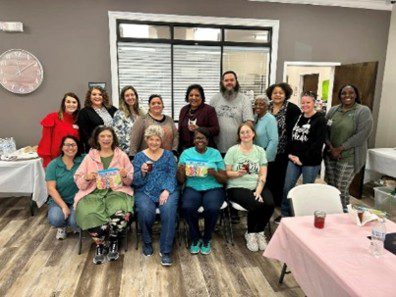
Figures 5. Garden to Pantry participants.
The Garden to Pantry program was developed in response to this need, offering participants a comprehensive, hands-on experience that bridges the gap between growing food, preserving it, and effectively using it in cooking. By providing a holistic approach, the program empowers individuals to understand the entire food cycle—from planting seeds in the garden to using proper long-term food preservation techniques.
The importance of food preservation cannot be overstated. When done correctly, these techniques help maintain the quality and nutritional value of food, preventing foodborne illnesses and extending the shelf life of produce beyond its growing season. This not only helps reduce food waste but also plays a crucial role in enhancing food security and nutrition, especially for those in underserved communities.
Outputs: In 2024, a collaboration among Food Safety and Quality, Home Horticulture, and Human Sciences regional Extension agents resulted in the delivery of 10 Garden to Pantry workshops across the state. These workshops gave participants valuable knowledge in key areas essential for successful home gardening and food preservation, including planting techniques, pest management, food preservation methods, nutrition education, and cooking. Each workshop focused on one specific crop—tomatoes, blueberries, strawberries, green beans, or collard greens—and lasted between 2 and 4 hours.
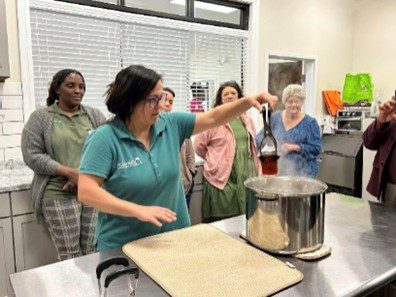
Figure 6. Garden to Pantry learning activities.
The workshops were a mix of informative presentations and hands-on activities designed to engage participants actively. Following the sessions, a post-assessment survey was conducted, with 129 participants providing feedback. The survey results indicated significant growth in participants’ confidence and understanding of key gardening and preservation practices:
- Pre- Versus Postworkshop Knowledge: Before attending the workshop, only 17 percent of participants rated their knowledge of growing the selected produce as “Extremely to Very Well.” However, after completing the training, that figure rose to 41 percent, demonstrating a significant boost in participants’ confidence and skills.
- Plans for Application: More than 80 percent of participants reported plans to apply the knowledge gained from the workshop to their own gardening practices, indicating that the training was not only informative but also actionable.
Participants shared their positive experiences as well. April from Clarke County expressed, “I believe the Garden to Pantry class will help my family. I fully intend to use what I learned when gardening and preserving food this fall.” Ann from Baldwin County added, “I believe the workshop was helpful for me and my family. I knew nothing about canning/preserving food before I attended the workshop. Now I feel more comfortable planting and canning.”
These workshops have successfully equipped participants with the skills to grow seasonal produce in their home or community gardens, better understand the nutritional benefits of fresh produce, and preserve their harvest safely to extend their shelf life.
Audience Diversity: The Garden to Pantry program attracted a diverse group of participants in 2024:
- 83% female; 17% male
- All adults.
- Racial and ethnic diversity:
- 92% White
- 7% Black
- Less than 1% identified as Other
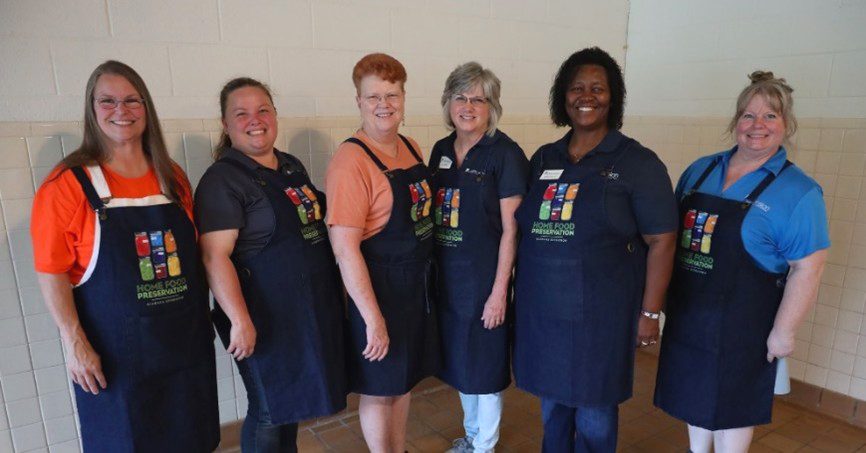
Figure 7. Garden to Pantry educators.
Evaluation Techniques: To assess the effectiveness of the Garden to Pantry program, a post-program survey was conducted with 129 respondents.
Value Statement/Synopsis: The Garden to Pantry program successfully empowers individuals by providing essential knowledge and hands-on skills in sustainable gardening, food preservation, and nutrition. Through a series of 10 interactive workshops held across the state, participants learned to grow and preserve seasonal produce, gaining confidence in food safety practices and cooking techniques. With a focus on practical application, the program has made a lasting impact, with more than 80 percent of participants planning to implement the skills learned in their own gardens. The program’s reach spans diverse communities, with 129 participants completing the post-program survey, reflecting a significant increase in gardening knowledge and enthusiasm for preserving food. By equipping participants with tools to improve food security, reduce waste, and enhance nutrition, Garden to Pantry is fostering healthier, more self-sufficient communities.
Revenue Generation: $1,548
Social Media Channels: www.facebook.com/acesfoodsafety/
Key Web Page: www.aces.edu/blog/category/food-safety/
Bridgette Brannon, Extension Agent, Food Safety and Quality, Auburn University
New May 2025, Food Safety & Quality Impacts 2024, ANR-3149
Past Reports
- Food Safety & Quality Team Outcomes and Impacts 2023, ANR-3064
- Food Safety & Quality Team Outcomes & Impacts Report 2021, ANR-2949
The Alabama Cooperative Extension System (Alabama A&M University and Auburn University) is an equal opportunity educator, employer, and provider. If you need a reasonable accommodation or language access services, contact Bridgette Brannon at huttobf@aces.edu.
